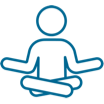
Relaxation
Relaxation is an all over feeling of calm. There are lots of different ways to relax, the key thing about relaxation is finding an activity which helps you to relieve some tension and helps you feel calm. This could be activities like fishing, reading, listening to music, yoga, tai chi and meditating.
After a brain injury or when you have chronic pain it can be frustrating if you can’t do the activities you found relaxing before. Tension can build up in the body and in the mind when you have ongoing pain. It can be hard to get rid of the stress and tension in the body when you can’t move or exercise due to pain and other physical changes. Getting wound up or tense doesn’t cause chronic pain, but it often makes it worse. This can lead to a cycle of pain → tension → more pain → more tension.
Being able to relax helps in all parts of your life. When you have chronic pain, relaxation can help to reduce tension, help you to calm yourself, feel more in control and stop the pain getting worse. You might have tried relaxation techniques before and not really got anywhere with them. It is important to focus on what you can do now and be open to trying out new activities or changing old activities so that you can still do them. This just means that it might take a bit more time and effort.
Learning to relax is not only about doing relaxing activities but also about getting rid of stress as well. Go to the Winding down your stress tools for help with this.
Relaxation is a skill, just like driving a car, cooking and playing golf are skills. You aren’t born with these skills, you learn them. The more practise you put in, the better you will be. The same goes for relaxation. The actual way you relax isn’t important, just as long as you do a little bit often.
Read through the Relaxation guide to find some ways to relax.
My relaxation plan
Now it is time to make your own relaxation plan. Think about the different ways you can relax and make a plan to do these on a regular basis. These are your tools to help you manage your anxiety and your pain. Just like with any new tool, you need to practise using it, so you need to make a plan about how often and when you are going to do the activity. That will mean that you are ready and confident that it will work in a time of stress.
A good relaxation plan has a few key parts – it is a good idea to have something from all of these in your relaxation plan
Mediation practice
Meditation is a more formal way of helping the mind and body to relax. Go to the Meditation guide to see some different kinds of mediation practices you can try – pick one that you could try.
Something you enjoy doing
From the activities in the Relaxation guide pick one or two things you can see yourself enjoying. Select one or two that you could do easily at the moment.
Physical activity
Movement and exercise are good for your body and your stress levels. It releases feel good brain chemicals and helps to take your mind off the things you are worrying about. Check out the Physical activity brick and pick one or two activities that you can do in a paced way.
Self-care or soothing activities
It is really important to take care of yourself. Self-care is about putting yourself first, taking care of what you need and doing some things that are important to you in your day. Self-care activities are things like eating well, getting enough sleep, learning something new or spending time in nature.
In the My Relaxation plan, pick one or two things to do from the four key areas above. To help make this into a plan, think about how often you can do each of these activities, when you can do them, on which day or days and at what time. Use the Relaxation guide and My Relaxation plan to learn to Be Pain Smart.